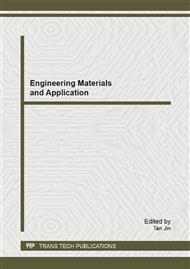[1]
R.F. Service, Nanotoxicology. Nanotechnology grows up, Science. 304(5678) (2004) 1732-1734.
DOI: 10.1126/science.304.5678.1732
Google Scholar
[2]
A. Nel, T. Xia, L. Mädler, N. Li, Toxic potential of materials at the nanolevel, Science. 311(5761) (2006) 622-627.
DOI: 10.1126/science.1114397
Google Scholar
[3]
G. Oberdörster, Safety assessment for nanotechnology and nanomedicine: concepts of nanotoxicology, J Intern Med. 267(1) (2010) 89-105.
Google Scholar
[4]
D.B. Warheit, What is currently known about the health risks related to carbon nanotube exposures? Carbon. 44 (2006) 1064-1069.
DOI: 10.1016/j.carbon.2005.10.013
Google Scholar
[5]
M. Geiser, W.G. Kreyling, Deposition and biokinetics of inhaled nanoparticles, Particle and Fibre Toxicology. 7 (2010) 2-17.
DOI: 10.1186/1743-8977-7-2
Google Scholar
[6]
R.A. Yokel, R.C. MacPhail, Engineered nanomaterials: Exposures, hazards, and risk prevention, J. Occup. Med. Toxicol. 6 (2011) 7.
DOI: 10.1186/1745-6673-6-7
Google Scholar
[7]
C. Mühlfeld, B. Rothen-Rutishauser, F. Blank, D. Vanhecke, M. Ochs, P. Gehr, Interactions of nanoparticles with pulmonary structures and cellular responses, Am J Physiol Lung Cell Mol Physiol. 294(5) (2008) L817-L829.
DOI: 10.1152/ajplung.00442.2007
Google Scholar
[8]
H.M. Mansour, Y.S. Rhee, X. Wu, Nanomedicine in pulmonary delivery, International journal of nanomedicine. 4 (2009) 299-319.
Google Scholar
[9]
J.M. Worle-Knirsch, K. Pulskamp, H.F. Krug, Oops they did it again! Carbon nanotubes hoax scientists in viability assays, Nano Lett. 6 (2006) 1261-1268.
DOI: 10.1021/nl060177c
Google Scholar
[10]
N.A. Monteiro-Riviere, A.O. Inman, L.W. Zhang, Limitations and relative utility of screening assays to assess engineered nanoparticle toxicity in a human cell line, Toxicol Appl Pharmacol. 234 (2009) 222-235.
DOI: 10.1016/j.taap.2008.09.030
Google Scholar
[11]
A. Kroll, M.H. Pillukat, D. Hahn, J. Schnekenburger, Current in vitro methods in nanoparticle risk assessment: Limitations and challenges, Eur J Pharm Biopharm. 72 (2009) 370-377.
DOI: 10.1016/j.ejpb.2008.08.009
Google Scholar
[12]
R. Tantra, A. Knight, Cellular uptake and intracellular fate of engineered nanoparticles: A review on the application of imaging techniques, Nanotoxicology. 5 (2011) 381-392.
DOI: 10.3109/17435390.2010.512987
Google Scholar
[13]
D.P. Allison, N.P. Mortensen, C.J. Sullivan, M.J. Doktycz, Atomic force microscopy of biological samples. Wiley Interdiscip. Rev. Nanomed. Nanobiotechnol. 2 (2010) 618−634.
DOI: 10.1002/wnan.104
Google Scholar
[14]
P.K. Hansma, B. Drake, O. Marti, S.A. Gould, C.B. Prater, The scanning ion-conductance microscope, Science. 243 (1989) 641-643.
DOI: 10.1126/science.2464851
Google Scholar
[15]
Y.E. Korchev, C.L. Bashford, M. Milovanovic, I. Vodyanoy, M.J. Lab, Scanning ion conductance microscopy of living cells, Biophys J. 73 (1997) 653-658.
DOI: 10.1016/s0006-3495(97)78100-1
Google Scholar
[16]
Y. Zhang, J. Gorelik, D. Sanchez, A. Shevchuk, M. Lab, I. Vodyanoy, D. Klenerman, C. Edwards, Y. Korchev, Scanning ion conductance microscopy reveals how a functional renal epithelial monolayer maintains its integrity, Kidney Int. 68 (2005).
DOI: 10.1111/j.1523-1755.2005.00499.x
Google Scholar
[17]
J. Rheinlaender, N.A. Geisse, R. Proksch, T.E. Schäffer, Comparison of scanning ion conductance microscopy with atomic force microscopy for cell imaging, Langmuir. 27 (2011) 697–704.
DOI: 10.1021/la103275y
Google Scholar
[18]
P. Novak, C. Li, A.I. Shevchuk, R. Stepanyan, M. Caldwell, S. Hughes, T.G. Smart, J. Gorelik, V.P. Ostanin, M.J. Lab, G.W. Moss, G.I. Frolenkov, D. Klenerman, Y.E. Korchev, Nanoscale live-cell imaging using hopping probe ion conductance microscopy, Nature Methods. 6 (2009).
DOI: 10.1038/nmeth1209-935a
Google Scholar
[19]
X. Yang, X. Liu, X. Zhang, H. Lu, J. Zhang, Y. Zhang, Investigation of morphological and functional changes during neuronal differentiation of PC12 cells by combined Hopping Probe Ion Conductance Microscopy and patch-clamp technique, Ultramicroscopy. 111 (8) (2011).
DOI: 10.1016/j.ultramic.2011.05.008
Google Scholar
[20]
A.I. Shevchuk, P. Novak, Y. Takahashi, R. Clarke, M. Miragoli, B. Babakinejad, J. Gorelik, Y.E. Korchev, D. Klenerman, Realizing the biological and biomedical potential of nanoscale imaging using a pipette probe, Nanomedicine (Lond). 6(3) (2011).
DOI: 10.2217/nnm.10.154
Google Scholar
[21]
X. Yang, X. Liu, H. Lu, X. Zhang, L. Ma, R. Gao, Y. Zhang, Real-Time Investigation of Acute Toxicity of ZnO Nanoparticles on Human Lung Epithelia with Hopping Probe Ion Conductance Microscopy, Chem Res Toxicol. 25(2) (2012) 297–304.
DOI: 10.1021/tx2004823
Google Scholar
[22]
P. Ruenraroengsak, P. Novak, D. Berhanu, A.J. Thorley, E. Valsami-Jones, J. Gorelik, Y.E. Korchev, T.D. Tetley, Respiratory epithelial cytotoxicity and membrane damage (holes) caused by amine-modified nanoparticles, Nanotoxicology. 6 (2012).
DOI: 10.3109/17435390.2011.558643
Google Scholar


